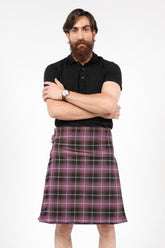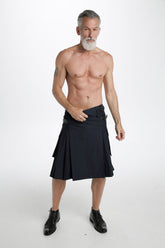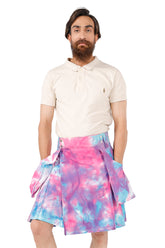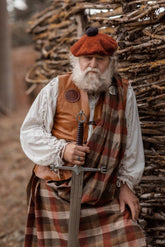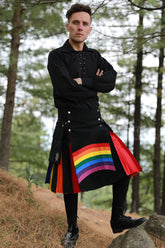What Did Scots Wear Before Kilts? Why Was Kilt Banned?
The Scottish kilt is an iconic symbol of Scottish heritage, but what did Scots wear before kilts, and why was the kilt banned? Take a journey through time to delve into the rich history of Scottish attire with a journey through time, exploring the traditional dress of Highlanders and the attire worn by Scottish warriors before the kilt's adoption. Investigating references from the 1500's, reveals different historical attire, sparking curiosity and addressing the confusion surrounding this transition. Highlighting the fact that what came before the kilt wasn't exactly a kilt as we know it today adds an interesting twist. This brings an element of curiosity, inviting us to explore and better grasp how Scottish clothing evolved before people started wearing kilts.
Léine Era before Kilts:
Before kilts became the symbol of Scottish heritage, the Scots wore a long shirt-like tunic called the léine, made from linen, which was accessible and cheap. This pre-kilt era in Scottish clothing history dates back to the 1500s. It was worn by both men and women and could be belted at the waist to give it shape. The léine was often dyed yellow and was worn with braies, which were like baggy shorts. Scots would also wear leather or animal furs for added protection against the cold. The léine croich was popular until the 16th century, when kilts began to rise in popularity. The evolution of Scottish clothing from léine to kilt highlights the adaptability and resourcefulness of the Scottish people in adapting to their environment and expressing their cultural identity.
Yellow Dye for Clothing in Scotland:
Before the widespread use of kilts in Scotland, the people wore bright yellow shirts, known as "leine croich," which were made from linen and dyed with various substances, including horse urine, bark, and crushed leaves. These yellow shirts were worn by both men and women and were a common part of the pre-kilt Highland dress. The yellow color was achieved using natural dyes such as sundew (Drosera rotundifolia) and St. John's Wort (Achlasan Chalum cille), which were fixed with alum. The bright yellow color of these shirts stood out in contrast to the more muted tones of the kilt, which has become a more iconic symbol of Scottish heritage. This traditional method of dyeing clothing with yellow dye has since been largely replaced by modern fabric dyes, but it remains an important part of Scottish history and culture.
Blue Painted Bodies:
The practice of painting bodies blue, particularly among the Scots during the Léine era, is a topic of historical interest and debate. While there is evidence that the ancient Celts, including the Picts, painted themselves blue using a dye derived from the woad plant, the specific practice among the Scots is not definitively documented. Julius Caesar first reported that the inhabitants of Northern Britain were believed to be the Picts and the Scots, an account of the Celts painting themselves blue with vitrum, possibly referring to woad, is one of the early historical references to this practice. The Picts, who lived in Scotland between the 6th and 9th centuries, are said to have battled while covered in woad body paint, which likely influenced the portrayal of the Scots in popular culture, such as in the movie Braveheart. The use of blue paint from the woad plant was a common practice among the ancient Celts, but its specific application to the Scots in the Léine era remains a topic of ongoing research and discussion.

What accessories did they wear?
In the Léine era, Celtic accessories were significant indicators of status and style. Men wore belts with tunics, while women fastened dresses with brooches. High-status individuals adorned themselves with torcs, semi-circular necklaces made of gold, silver, or iron. The iconic Scottish headgear, the tam o’shanter, was popular during this time. Additionally, ancient Celtic warriors wore ornate bronze helmets with decorative features like horns or animal motifs. Notably, Celtic warriors styled their hair in distinctive white spikes using lime. The Fly Plaid Brooch is also referenced, although its details are not fully elaborated. These accessories and styles were emblematic of the rich cultural heritage and unique fashion of the Léine era.
Transition to the Great Kilt:
The transition from the Léine era to the Great Kilt was a significant evolution in Scottish attire, influenced by the prevalence of sheep and acrylic wool and the practicality of the new garment, reflecting both practical and cultural changes. The Léine, a traditional garment made of linen, was worn with a belted plaid or great kilt, which eventually developed into the modern kilt. This transition occurred over centuries, with the Kilt providing more practicality and protection against the harsh Scottish weather. The Great Kilt, a full-length garment, was versatile and could be worn as a cloak or brought up over the head as a hood. This evolution marked a shift towards a more functional and iconic piece of Scottish attire, ultimately becoming synonymous with Scottish culture and heritage. The incorporation of new fabrics, colors, and styles in the modern kilt has further enhanced its versatility and relevance in the 21st century.
When did Scots start wearing kilts?
The Scots started wearing kilts in the 16th century, the knee-length garment that we see today emerging in the early 18th century. The word "kilt" is derived from the ancient Norse word "kjilt," meaning "pleated," and it refers to clothing that is tucked up and around the body. It was born in the late 1500's, and it became the number one choice for Scots due to its protection against the cold and wet Scottish winters. The kilt, a garment resembling a wrap-around knee-length skirt, is a symbol of Scottish culture and heritage. Before the kilt, Scottish Gaels wore the same clothes as their Irish counterparts, namely a shirt known in Gaelic as the léine and a semi-circular mantle known in Gaelic as the brat. The kilt originated in the first quarter of the eighteenth century, evolving from the “big wrap” or belted plaid, the first identifiably “Scottish” costume that emerged in the late sixteenth century. Today, the kilt remains an important symbol of Scottish culture and tradition, often worn at special events such as weddings, graduations, Highland games, and formal occasions, reflecting the changing needs and tastes of a new generation of Scots.
Why did Scots start wearing kilts?
The Scottish kilt is a garment that has deep cultural and historical roots. The first record of the Scottish kilt is from the 16th century, and this was the great kilt, the breacan or belted plaid, which was a full-length garment whose upper half could be worn as a cloak, pulled up over the head, or draped around the shoulder. The kilt was initially worn by those who lived in the Scottish Highlands, and it was a manner of dress that afforded the fighting army possibly its most useful tool. But Why Did Scots Wear Kilts? The answer lies in its practical design, which provides enhanced mobility, allowing those who wear it to move much more freely, especially in the Highlands of Scotland, where the weather can become very damp. With its tight weave of strong wool, it created a barrier between the rain and the skin. Today, the Scottish kilt remains an important part of Scottish culture and tradition and is often worn at special events such as weddings, graduations, and the Highland Games.
When was the kilt banned in Scotland?
The kilt was banned in Scotland in 1746 by the English Crown, following the Jacobite rebellion in the Highlands. The ban, which lasted 35 years, was imposed to suppress the rebellion and was part of a series of measures to bring the clans under government control. The Dress Act of 1746 declared the wearing of kilts illegal, with severe consequences for those found in violation. However, by 1782, the ban was lifted as the fear of a Scottish uprising had diminished. The kilt, once considered a symbol of rebellion, eventually became a powerful symbol of Scottish identity. Today, it is embraced as a distinguished representation of Scottish patriotism, whether in formal celebrations or casual events. The ban inadvertently intensified the significance of the kilt as a symbol of Scottish identity, leading to its enduring popularity.
End of Kilt Ban:
The kilt was banned in the 18th century by the British government, aimed at suppressing the Jacobite rebellion in the Highlands. The Dress Act of 1746 prohibited the wearing of kilts and tartans, with severe consequences for those found wearing them. The ban was lifted in 1782, but decades of inactivity caused the kilt to fade out of fashion. However, the ban had an unintended consequence: it turned the tartan into a potent symbol of Scottish individuality and patriotism. Today, the kilt is considered a distinguished symbol of Scottish identity and is embraced as a cultural representation of patriotism.
Do Scottish people still wear kilts?
Yes, many Scottish people still wear kilts as a proud symbol of their heritage and culture. The kilt is often worn at formal events, weddings, and Highland games, and it remains an important part of Scottish traditional dress. In addition, there has been a resurgence in the popularity of kilts as everyday wear, with modern designs and materials making them more versatile and comfortable. This iconic garment not only reflects Scotland's rich history but also serves as a distinctive and eye-catching fashion statement. Whether donned for special occasions or as part of everyday attire, the kilt continues to be a cherished and enduring symbol of Scottish identity.
Kilt Up!
When looking to buy a kilt, consider the timeless elegance and cultural significance of this traditional Scottish garment. Fashion Kilt offers a wide range of high-quality men's kilts, perfect for various occasions. Whether it's a formal event or a casual gathering, we provide authentic and well-crafted options to suit your needs. Embrace your heritage or make a bold fashion statement with a kilt from us. By choosing a kilt from us, you can be confident in the authenticity and quality of your purchase. Explore our collection to find the perfect men's kilt for you and kilt up with style. Elevate your wardrobe with a touch of Scottish tradition—your go-to kilt provider!
FAQs
Was there a specific reason for the ban on kilts?
The ban on kilts, part of the Dress Act of 1746, was a deliberate effort to suppress Highland culture and force assimilation into Lowland Scottish and English culture. It was a consequence of the Jacobite uprisings and was aimed at subduing Highland identity and loyalty.
What factors led to the popularity of kilts in Scottish culture?
The popularity of kilts in Scottish culture can be attributed to their functionality, protection against the harsh climate, and their eventual association with Scottish national identity and heritage.
What are some misconceptions about the history of Scottish clothing?
One common misconception is that kilts have always been a part of Scottish attire. In reality, the emergence of the kilt as a significant garment in Scottish culture is a relatively recent development, dating back to the late 16th century.
When did the kilt become a part of Scottish attire?
The kilt, as we know it today, emerged in the late 16th century, making it a relatively recent addition to Scottish traditional dress. Before that, the prevalent attire was the léine, a long tunic-like garment.
What are some popular occasions to wear a kilt?
Some popular occasions to wear a kilt include weddings, formal events such as black tie dinners and graduation ceremonies, social gatherings like ceilidhs, and sporting events such as football or rugby matches. The kilt is a versatile garment suitable for a wide range of events, reflecting its cultural significance and adaptability.

